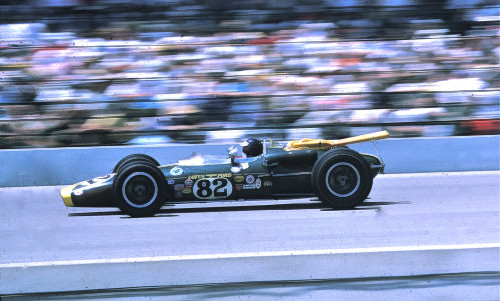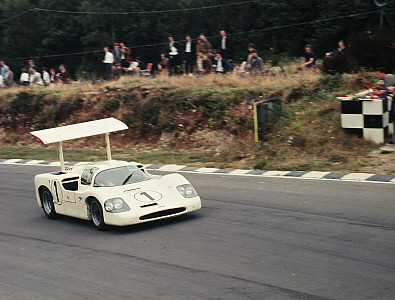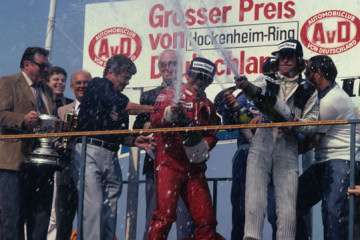The Way It Is/ Recalling a great eraby Gordon Kirby |
 If you're a Motor Sport reader you'll know about the survey the magazine conducted this summer in which the readers chose Jim Clark by a large margin as their favorite of the UK's ten world champions. Clark drew 31.5 percent of the 5,500 votes well ahead of second-placed Nigel Mansell's 13.1 percent. The list included non-champion but four-time runner-up Stirling Moss who got 10.9 percent of the votes, three-time champion Jackie Stewart, two-time champion Graham Hill and one-time champions Mike Hawthorn, John Surtees, James Hunt, Damon Hill, Jenson Button and Lewis Hamilton.
If you're a Motor Sport reader you'll know about the survey the magazine conducted this summer in which the readers chose Jim Clark by a large margin as their favorite of the UK's ten world champions. Clark drew 31.5 percent of the 5,500 votes well ahead of second-placed Nigel Mansell's 13.1 percent. The list included non-champion but four-time runner-up Stirling Moss who got 10.9 percent of the votes, three-time champion Jackie Stewart, two-time champion Graham Hill and one-time champions Mike Hawthorn, John Surtees, James Hunt, Damon Hill, Jenson Button and Lewis Hamilton.
It's interesting that the Brits have many more F1 world champions than any other country and further proof, if needed, that the UK has been at the center of F1 for the past fifty and more years. Brazil and Finland are ranked second, both with three world champions. Brazil's champions were Emerson Fittipaldi, Nelson Piquet and Ayrton Senna. Finland's were Keke Rosberg, Mikka Hakkinen and Kimi Raikkonen. America of course has two world titles to its credit--Phil Hill in 1961 and Mario Andretti in '78. Clark's dominance of Motor Sport's poll wasn't a surprise because he served as an inspiration to a generation or two of racers and fans around the world and his yellow-striped Lotuses have achieved an iconic status in the sport equal to Ferrari's red cars. Clark was a true world champion, racing and winning not merely in Formula 1 but also in Indy cars, sports cars, Tasman cars, Formula 2, touring cars and giving both NASCAR and rallying rousing tries. And of course, the Scotsman was a gentleman on and off the track, a fierce but clean racer who was humble, soft-spoken and without guile.  © Racemaker/Knox Dan also joined Carroll Shelby's Cobra assault on European sports car racing in 1964, '65 and '66. He won the GT class at Le Mans in '66 with Bob Bondurant aboard a Cobra Coupe and won the 24 Hours outright the following year with A.J. Foyt in a Ford mk IV. Gurney was part of a great wave of Americans who ventured to Europe to race successfully in the 50s and '60s. Among them were Phil Hill, Richie Ginther, Shelby and Masten Gregory. Hill won the 1961 world title with Ferrari and also won Le Mans three times for Ferrari between 1958-'62 co-driving with Belgian Olivier Gendebien. Hill also was a gentlemanly, introspective man and back in those days the sport had such an impact on American culture that each of Hill, Clark and Gurney regularly graced the covers of Road & Track, Sports Car Graphic and other major magazines. Indeed in the late fifties and through the sixties American race fans cheered, albeit briefly, for Lance Reventlow and his Scarab F1 and sports cars as well as Hill, Ginther and Gurney in F1. Then came Shelby's Cobras and Ford's GT40s which showed what American V8-powered cars could do. Ford, Firestone and Goodyear also took the likes of Bondurant, Jerry Grant, Mario Andretti, A.J. Foyt, Lloyd Ruby and Roger McCluskey to Europe while Roger Penske raced at Le Mans in a NART Ferrari in 1962 and won at Brands Hatch in the UK the following year driving his famous Zerex Special. And of course Jim Hall took his Chaparrals to Europe in 1966 and '67 with Phil Hill as his lead driver and they proceeded to beat Ferrari, Ford and everyone else in the Nurburgring 1000K in '66 and at Brands Hatch the following year. Hill quietly retired after his win with Mike Spence at Brands Hatch to become one of the world's finest car restorers and a fine writer too. The sixties also witnessed the height of international racing in America. The US Grand Prix flourished at Watkins Glen, attracting huge crowds and media attention. Sebring and Daytona were key rounds in the World Sports Car Championship and both the Can-Am and Trans-Am came to life in the mid-sixties and rapidly escalated themselves into major racing series, if only for fleetingly brief periods of time. The Can-Am began to take shape in the late fifties and early sixties with people putting American V8s into specials like 'Old Yeller', then applying the same concept to more sophisticated Lotus 19s and Cooper Monacos. Then came the early McLarens, Lola T70s and Chaparrals and ultimately the Porsche 917/10 and 917/30K with which Mark Donohue, George Follmer and Penske's team trounced the opposition in 1972 and '73. By the end of the following year the original, unlimited Can-Am was dead, killed by rapidly escalating technology and costs and the inability of the sanctioning body to manage the technical, financial and promotional issues. Indy car racing also enjoyed a massive boom through the sixties. The arrival at Indianapolis in 1963 of Clark, Gurney and Colin Chapman's Ford-powered Lotuses brought not only the rear engine revolution to Indy cars but also revolutions in tire technology, aerodynamics and turbocharging. Through the sixties and early seventies the level of technology and lap speeds at Indianapolis climbed sharply and we were also treated to a flush of top F1 drivers, including Graham Hill, Jackie Stewart, Jack Brabham, Denny Hulme and Jochen Rindt, and car builders like Lola and McLaren chasing in the wheeltracks of Clark, Gurney and Lotus at Indianapolis.  © LAT Meanwhile American participation in international racing began to wane as the seventies arrived but we didn't seem to notice because of guys like Mario Andretti and Roger Penske. Andretti pursued his F1 career through the seventies while continuing to race Indy cars in America. After starting in F1 with Lotus on a part-time basis in 1968 and '69 Mario drove an STP March for Andy Granatelli in half a dozen races in 1970. He joined Ferrari in 1971 and '72, still on a part-time basis, and scored his first world championship victory in South Africa. Andretti returned to F1 near the end of 1974 with a California-built Parnelli which he raced regularly through the beginning of '76 before re-joining Lotus later that year and finally winning the world championship in '78. Roger Penske also ran an F1 team during this time from the end of '74 through '77 with Mark Donohue and then John Watson driving. And Peter Revson returned to F1 with McLaren in 1972 and won two Grands Prix with the team before he was killed while testing a Shadow F1 car in the spring of 1974. Meanwhile Andretti left Lotus at the end of 1979 to drive for Alfa-Romeo in 1980 and '81 before finishing his F1 career with two races for Ferrari at the end of '82. During that time we also witnessed the birth of the Long Beach GP and a few years of it thriving as an F1 race. We lost Watkins Glen in 1980 after twenty years as the home of the US Grand Prix but for a few years there were a bunch of street circuits eager to join Long Beach with additional if fleeeting F1 races in Las Vegas, Dallas and Detroit. But Vegas and Dallas failed while Long Beach and Detroit switched to CART's more economical Indy car series. So we enjoyed a lot of American F1 drivers, teams and races through the sixties, seventies and early eighties. But then came a precipitous drop-off as Andretti returned to America in 1982 to race Indy cars full-time for the final twelve yars of his epic career. Through the eighties Eddie Cheever flew America's flag in F1, ultimately starting more F1 races than any other American. And in 1985 and '86 Carl Haas became the last man to field an American F1 team with his Beatrice-sponsored, Ford-powered cars driven by Alan Jones and Parick Tambay.  © Paul Webb I learned first-hand back in 1972 how deeply competitive European open-wheel racing when I helped my friend David Loring race a Merlyn Formula Ford in the UK. The previous year David had won 21 Formula Ford races and four championships in the United States and Canada. He hoped to race Formula 3 in '72 but couldn't afford it and had to settle for Formula Ford, winning five races and battling for the lead in the first Formula Ford Festival at the end of the season. Without the money or sponsorship to continue we had to come home and David went on to win the 1978 American FF championship with Dan Gurney's Eagle. Later he won a bunch of IMSA races in Camel Light and GT cars but to this day he looks back on his season in the UK as the most instructive year of his life. And that's because Europe and the UK is where the world's racing talent assembles to prove itself. Today, as globalization proceeds on its inevitable path, there's a bigger worldwide talent pool than ever so the depth of competition is similarly stronger than ever in Formula Ford, F3 and the lower levels of the European ladder system. And indeed, it's this international talent pool that has taken over IndyCar, Indy Lights and the American open-wheel ladder system in recent years. It's important to emphasize that motor sport as a whole in all its many diverse forms across America and around the world is broader and deeper than ever. There are a huge number of participants and that number is growing rapidly around the world. From midgets and sprint cars to vintage and historic racing there's a very healthy pool of competitors and fans. We've come a long way over the last half-century but it's difficult to argue that it's turned into a happy or, dare I say, proud ride for big-league open-wheel and road racing in America. We're all looking for leadership and ways to make the sport better, to rekindle the fabulous spirit of the sixties and seventies when guys like Jim Clark, Dan Gurney, Phil Hill, Colin Chapman, A.J. Foyt, Parnelli Jones, Jim Hall, Bruce McLaren, Roger Penske, Mark Donohue and Mario Andretti captured our imagination. |
Auto Racing ~ Gordon Kirby Copyright 2012 ~ All Rights Reserved |
